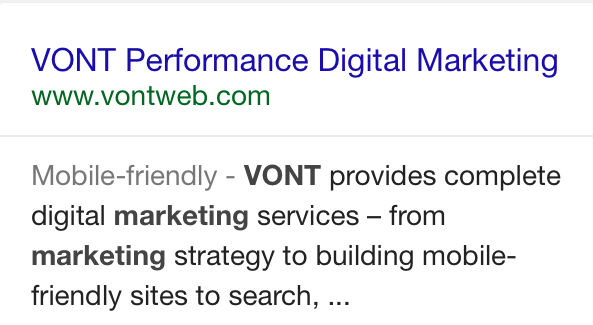
On April 21, 2015 Google once again rocked search engine optimization (SEO) marketing world with a new algorithm change. Google called it a “mobile friendly update,” but it quickly earned the name, “Mobilegeddon”.
Why? Because its main directive was to decrease the rankings of any website that was not optimized for viewing on mobile devices. While this update is relatively old news, its repercussions will continue to impact marketers in the coming year.
A few mobile-friendly stats
Why all the fuss about mobile-friendly websites?
- In May of 2015, Google confirmed that more Google searches take place on mobile devices than on computers in 10 countries including the US and Japan, and mobile searches now exceed desktop searches worldwide. [See Google]
- Fifty-seven percent of users say they won’t recommend a business with a poorly designed mobile site. [Compuware, 2011]
- The user-friendly interface of a mobile optimized webpage or app has been shown to increase retail conversions by 160%. [Internet Retailer, 2014]
- 87% of Millennials admit to never being without their phone and 14% wouldn’t do business with a company that doesn’t have a mobile site or app. [USA Today, 2014]
While there are many elements to mobile marketing, getting your website optimized for mobile devices is a logical first step, as well as a crucial part of attracting and converting prospects in 2016 and beyond.
Optimizing your site for mobile
So how do you get started?
Here are a few steps to get you heading in the right direction.
Evaluate Your Current Mobile Site Traffic
How many of your site visitors are already finding you on a mobile device? This is an important metric to track as you benchmark the growth of mobile among your prospective buyers and evolve your mobile strategy to suit them.
You can easily figure this out with Google Analytics by following these steps.
1. Login> Advanced Segments> select “all visits” and “mobile traffic”>apply. Now, under the Advanced Segments button, you should see a percentage of mobile visits to your site.
2. To drill down even further and discover exactly which type of mobile devices your site visitors are using, click the “standard reports” button >mobile>devices. Not only can this information help you with your mobile strategy moving forward, especially if you plan to develop an App, it will help you get to know more about your prospects.
Evaluate your current mobile friendliness
Figuring out where you stand today is an important first step to improving your site’s mobility tomorrow.
Here are a few ways to do this:
1. Access your website with a mobile device, and look for the “mobile-friendly” label in Google search results, which looks like this:

2. Use Google’s mobile-friendly testing tool where you simply type in the URL of your site and wait a few seconds for it to be analyzed.
3. For more advanced information, take a look at the mobile usability reports in the Google Search Console (fka Webmaster Tools).
To do this, login and click Search Traffic>Mobile Usability. Now you’ll get a page-by-page look at mobile strengths and weaknesses throughout the page.
Remember that this information will not be real-time since it provides data based on the last time Google’s bots crawled your site. If it’s been a while, you can always ask Google to crawl your URL.
It’s important to evaluate and test each individual page, not just the home page of your website. The third approach explained above is the best way to do this. The tools above will tell you exactly what to do to improve the mobile optimization of your site.
Building Your Mobile Site
If you find you need more than just a few tweaks to pass Google’s test, or and you need to build a new mobile website, you essentially have three options:
1. Create a mobile version of your website. There are many tools known as conversion platforms available to help you do this such as Duda Mobile or GoMobi. This is by far the fastest way to get mobile, but it also means you’ll be creating an entirely separate site that you’ll have to manage and update separately.
2. Use plugins. For companies who use popular content management systems (CMS) such as WordPress, Joomla, or Drupal, etc. you can use plugins that automatically make your site mobile and do not require you to manage content in two places. This can get a little tricky when it comes to page layout though. Learn more about these solutions in Google’s Guide.
3. Recreate your site using responsive web design. Put most simply, this design will allow your site’s layout, content, images, and elements to adapt based on the device from which it’s being accessed. This is Google’s favorite form of mobile website and provides an outstanding experience for mobile visitors, however it’s a lot more work on your part.
The takeaway
As 2016 draws closer, businesses large and small should come to terms with the importance of mobile-friendly websites; what was once considered “nice to have,” has become an absolute necessity and a crucial investment for the future of your business. Have you gone mobile yet?
About VONT Performance Digital Marketing
At VONT we believe that change is the only constant in the digital world – and that excites us. When tools and environments are constantly changing, new opportunities to help our clients achieve success are constantly arising. Each new advertising technology, social platform, or design approach allows us to improve on the results we achieve for our clients.
We believe in this idea of continual fine-tuning so much that we named our company VONT, which means to achieve exponential improvement in incremental steps. It is our core belief, and the reason why we are not simply a web design company or simply a digital advertising agency, but rather a long-term, single source partner providing a comprehensive array of web development and digital marketing capabilities.
In short, we’re here so that our clients achieve success in the ever-changing digital world. If you’d like to learn more about VONT and the work we’ve done with our client partners, visit our Work page. Or, if you have a question, contact us. We’ll get right back to you!

